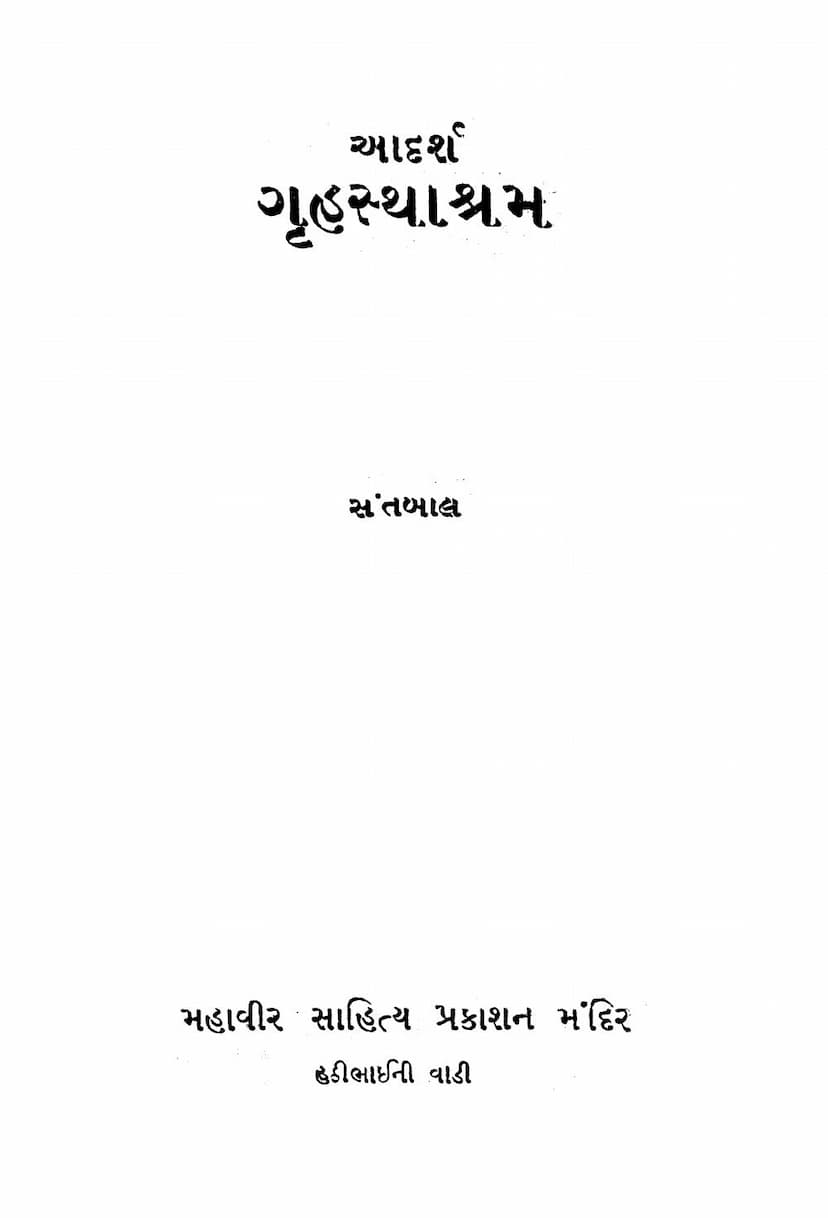Aadarsh Gruhasthashram
Added to library: September 1, 2025

Summary
This is a comprehensive summary of the Jain text "Aadarsh Gruhasthashram" (Ideal Householder Life) by Santbal, published by Mahavir Sahitya Prakashan. The book, as indicated by the provided Table of Contents and introductory sections, aims to guide readers towards an ideal householder life within the framework of Jain principles.
Overall Goal: The book's primary objective is to provide practical guidance for establishing and maintaining an ideal householder life, emphasizing that householder life itself is a significant path for spiritual development and societal contribution.
Structure of the Book: The book is divided into three main sections:
-
Nirdesh Khand (Guidance Section): This section lays the foundational understanding of the householder life.
- Historical Perspective: It begins with a historical overview of social structures and the evolution of different life stages (ashramas).
- Brahmacharya Ashram: It highlights the importance of the celibate student life as the foundation for all subsequent ashramas.
- Direction of Subjects: It discusses the relationship and distinction between the householder ashram and ascetic ashrams.
- Position of Grihasthashram: It explains the significant role and position of the householder in social, national, and religious contexts.
- Discussion on Marriage: It delves into the topic of marriage, its ideal purpose, and the principles of a fulfilling marital life, addressing contemporary issues related to marital arrangements.
-
Kartavya Khand (Duty Section): This section focuses on the duties and responsibilities within the householder life.
- Duties of Husband and Wife: It elaborates on the mutual duties of spouses.
- Parental Duties towards Children: It outlines the responsibilities of parents towards their offspring.
- Children's Duties towards Parents: It discusses the obligations of children towards their parents.
- Duties towards Extended Family: It covers the duties towards in-laws, siblings, and other family members.
- Neighborly Dharma: It emphasizes the importance of good conduct and responsibilities towards neighbors.
- General Duties: It includes responsibilities towards society, employers, and the nation.
- Politics and Subjects: It touches upon the relationship between governance and the populace.
- Social Service: It discusses the development of a service-oriented mindset.
-
Vikas Khand (Development Section): This section explores the broader development aspects related to householder life.
- Economic Activities: It discusses financial activities and their ethical conduct.
- Social Dharma: It elaborates on responsibilities towards society.
- National Dharma: It covers duties towards the nation.
- Spiritual Dharma: It explains the path towards spiritual growth and realization within the householder context, emphasizing virtues like morality, humanity, integrity, duty, and spirituality.
Key Themes and Concepts:
- Ideal Householder Life: The book emphasizes that the householder life, when lived according to principles, is not an impediment to spiritual progress but a vital stage for it. It provides a framework for a life that is both materially supportive and spiritually enriching.
- Importance of Brahmacharya: The foundational stage of Brahmacharya (celibacy and disciplined student life) is presented as crucial for developing the strength and character needed for a successful householder life.
- Mutual Duties and Responsibilities: A significant portion of the book is dedicated to outlining the detailed duties and responsibilities within family relationships – between husband and wife, parents and children, siblings, in-laws, and neighbors.
- Balance and Harmony: The text stresses the need for balance in life, particularly in managing desires and duties. It promotes a life that is not just about material gain but also about spiritual growth and contributing to the welfare of others.
- Societal Contribution: It highlights that the householder's role extends beyond the family to encompass responsibilities towards the community, nation, and even the world, fostering a sense of universal brotherhood and service.
- Ethical Conduct in Economic Activities: The book addresses the importance of ethical practices in earning a livelihood, emphasizing honesty, fairness, and contributing to societal well-being through one's profession.
- Spiritual Growth within Grihasthashram: It asserts that spiritual development is possible and encouraged within the householder stage through adherence to principles of non-violence (ahimsa), truthfulness (satya), non-stealing (asteya), non-possession (aparigraha), and celibacy (brahmacharya), even within the context of married life.
- Addressing Social Issues: The book implicitly or explicitly addresses contemporary social challenges like marital discord, the importance of proper marriage customs, the plight of widows, the impact of Western influence, and the need for societal reform.
- The Role of Elders and Youth: It discusses the dynamics and responsibilities between elder generations and the youth, emphasizing mutual respect and understanding.
- Community and National Dharma: The book elevates the concept of duty from the individual and family level to the community, societal, and national levels, advocating for selfless service and contribution.
- Spiritual Dharma (Vishva Dharma): The ultimate aim is the attainment of spiritual realization or Vishva Dharma (universal dharma), which encompasses love, compassion, and a sense of oneness with all beings, transcending narrow sectarian or familial bonds.
In essence, "Aadarsh Gruhasthashram" aims to be a comprehensive guide for Jains (and broadly for anyone seeking a principled life) to navigate the complexities of householder life with virtue, responsibility, and a focus on spiritual and societal upliftment. It bridges the gap between worldly duties and spiritual aspirations, presenting the householder's life as a sacred path towards ultimate liberation.